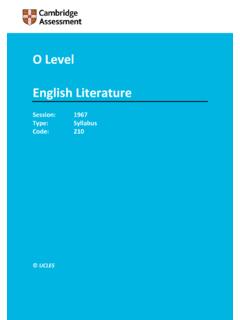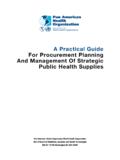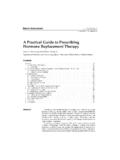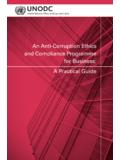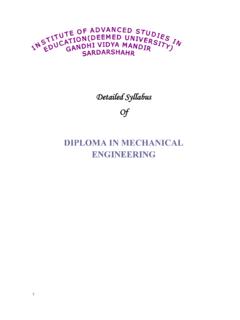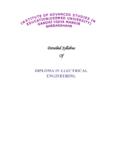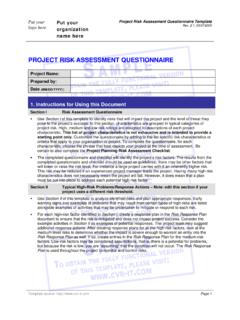Transcription of CRITERION REFERENCED ASSESSMENT AS A …
1 Sylvia Green, UCLES, ASEESA 2002, South of Cambridge Local Examinations SyndicateCRITERION REFERENCED ASSESSMENT AS A guide TO LEARNING -THE IMPORTANCE OF PROGRESSION AND RELIABILITYS ylvia GreenA paper presented at the Association for the Study of Evaluation in Education inSouthern Africa International ConferenceJohannesburg, 10 July 12 July 2002 DisclaimerThe opinions expressed in this paper are those of the author and are not to be taken asthe opinions of the University of Cambridge Local Examinations DetailsSylvia GreenHead of Primary ASSESSMENT UnitResearch and Evaluation DivisionUniversity of Cambridge Local Examinations SyndicateSyndicate Buildings1 Hills RoadCambridgeCB1 2 EUEnglandTel. +44 1223 553844 Fax. +44 1223 552700email Green, UCLES, ASEESA 2002, South REFERENCED ASSESSMENT as a guide to learning the importance ofprogression and reliabilityOne of the aims of CRITERION referencing is to focus on individual, differentiated ASSESSMENT .
2 Bymoving away from norm-referencing, to a system which describes what students know,understand and can do, assessments can be used to provide feedback and to inform futureteaching and learning needs. Where ASSESSMENT is carried out based on descriptions of levels ofperformance, we need to define success at a given level. In England, level descriptions set outthe expected standards of performance. They describe the types and range of performance thatstudents at a particular level should characteristically demonstrate. The level descriptions createan age independent scale which allows for differentiation and ASSESSMENT of progression for eachcurriculum subject. The detailed curricula are set out in the Programmes of Study for eachsubject and are age specific for each stage of learning. One advantage of age independentscales of performance is that they allow for overlap between age groups and differentiation at anyparticular age.
3 The assumption is that it is possible to define progression in a given subject andthat an age independent scale of progression exists. It could be argued that for some subjectsprogress is more easily defined, whereas for others definitions of progress may be are a number of difficulties related to this model of teaching, learning and levels of performance are described in holistic terms, requiring interpretation and humanjudgement, there is a danger that reliability will be compromised. For true CRITERION referencing,experts would not accept criteria which could allow a range of interpretations. However it couldbe argued that no CRITERION , no matter how precisely phrased, admits of an unambiguousinterpretation , (Wiliam, 1993). The development of criteria which would not allow a range ofinterpretations would be challenging and arguably such criteria would be too numerous, narrowand order to reconcile the problems of unreliable human judgements and the need for rigorousassessment, it is necessary to develop a shared understanding of holistic descriptions ofperformance.
4 Those involved in ASSESSMENT , test development, teaching and curriculumdevelopment need to understand levels of performance and the nature of progression in thecurriculum and to develop an understanding of standards of performance within a community ofpractice. Such a body of knowledge would help to increase the credibility of valid, reliableassessment of what students know, understand and can do in the context of transparency, clarityand shared Green, UCLES, ASEESA 2002, South REFERENCED ASSESSMENT AS A guide TO LEARNINGTHE IMPORTANCE OF PROGRESSION AND RELIABILITYI ntroductionThe introduction of outcomes based education has led to new challenges in curriculumdevelopment and integrated ASSESSMENT . The need for clearer teaching objectives and morevalid assessments can lead to a number of potential difficulties. It is a challenging task to assessperformance in a meaningful, manageable way while ensuring reliability and fundamentalprogression in the curriculum.
5 O Neil (1994) suggested that problems stem from a failure todefine outcomes clearly and to describe how they can be demonstrated for REFERENCED ASSESSMENT of a more complex curriculum poses a great technical challengeas can be seen from the experience of implementing the national curriculum and assessmentprocedures in REFERENCED assessmentOne of the aims of CRITERION referencing is to focus on individual ASSESSMENT based ondescriptions of performance across a range of levels. While norm-referencing providesinformation about an individual s performance against that of others, CRITERION referencing is anattempt to provide information about standards by describing the knowledge and skills which arecharacteristic at a given level of attainment. Brown defined CRITERION REFERENCED ASSESSMENT as,An evaluative description of the qualities which are to be assessed ( anaccount of what pupils know and can do) without reference to the performance ofothers.
6 (Brown, 1988, )Assessments based on descriptions of levels of performance can be used to provide feedbackand to inform future teaching and learning needs. For such a system to be effective it isimportant that teaching programmes are aligned with the expected outcomes which are any scale of performance descriptions it is necessary to define success at a given level and asRidgway commented,..the definition of mastery is not always clear. It would be impractical to expectcandidates to attain perfect scores on every aspect of every task on which theywere [we] are faced with the task of making decisions about the level ofsuccess which counts for mastery. (Ridgway, 1988, )Sylvia Green, UCLES, ASEESA 2002, South England, the detailed curriculum is set out in programmes of study for each subject and theseprogrammes of study are age specific for each stage of learning.
7 (appendix 1 extract fromprogramme of study for writing at key stage 3). There are three key stages between the ages of5 and 14 years: key stage one - ages 5 7; key stage two - ages 8 11; key stage three - ages12 14. The programmes of study provide the basis from which units of work can be developedfor teaching and everyday ASSESSMENT . Details of the curriculum are documented nationally sothat teachers can plan their teaching, giving pupils opportunities to show what they know,understand and can do. Alongside the programmes of study are the level descriptions which provide benchmarks and setout expected standards of performance (see appendix 2, level descriptions for writing).They describe the types and range of performance that pupils working at a particular level shouldcharacteristically demonstrate. For continuous ASSESSMENT teachers judge which leveldescription best fits a pupil s performance.
8 By indicating expectations at particular levels andprogression in the subject, the level descriptions can help to inform planning for teaching andlearning. The level descriptions are used in the development of national test mark schemes. Forexample, in national tests for English, the mark schemes for writing are derived from the criteriaof the level descriptions which are applied to the specific writing tasks in the test (see appendix 3, extract from national test mark scheme for writing at key stage 3). A range of marks is available for a given level and the marker judges how much of a descriptionthe pupil has achieved and awards marks accordingly. In such mark schemes the leveldescriptions are fundamental to the CRITERION REFERENCED ASSESSMENT . In other subjects, such as science, the links between the level descriptions and the national testmark schemes are not so transparent.
9 Different elements within structured questions mayaddress different levels and content, even different domains within the subject, therefore it maybe difficult to classify some questions as at a particular level . In such circumstances standardsetting is done by determining thresholds in total test scores, initially by judgemental means andsubsequently using statistical equating to support judgements. In subjects such as writing, wherethe mark schemes are more directly related to the level descriptions, the standard setting alsoinvolves setting thresholds judgementally and statistically, but with more transparent links tolevels of Green, UCLES, ASEESA 2002, South 1988 a Task Group on ASSESSMENT and Testing (TGAT) was set up by the Secretary of Statefor Education in England. The group was asked to advise on practical considerations governingassessment within the national curriculum.
10 TGAT proposed that ASSESSMENT should be anintegral part of the educational process, continually providing feedback about performance andprogress and feedforward about the next steps for teaching and learning. It was suggested that, criteria for ASSESSMENT and levels of performance should be related toexpected routes of educational development, giving some continuity toa pupil s ASSESSMENT at different ages and thereby giving a detailedpicture of each pupil s progress . (TGAT Report, 1988, )One of the advantages of the age independent scale proposed by TGAT is that a common set ofbenchmarks apply across the age ranges, as in England across key stages 1, 2 and 1 Sequence of attainment between ages 7 and 14 years (adapted from 104, figure 1, TGAT Report, 1988) Levels87654321 7 8 9 10 11 12 13 14 Age (years)Sylvia Green, UCLES, ASEESA 2002, South advantage is that it allows differentiation at any particular age and as Wiliam comments, the age independent scale was the result of a clear priority to providea system that allows students to experience progression (in order topromote a view of attainment as incremental rather than as fixed)





